|
|
|
Sort Order |
|
|
|
Items / Page
|
|
|
|
|
|
|
| Srl | Item |
| 1 |
ID:
140611


|
|
|
|
|
| Summary/Abstract |
The motivations for the birth of ASEAN were so that its members’ governing elite could concentrate on nation building, the common fear of communism, reduced faith in or mistrust of external powers in the 1960s, and a desire for economic development. In the international political scenario, the ASEAN is the successor of ASA (Association of Southeast Asia) which was formed in 1961. It consisted of a group of countries including Philippines, Malaysia, and Thailand.
|
|
|
|
|
|
|
|
|
|
|
|
|
|
|
|
| 2 |
ID:
140614
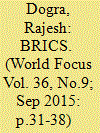

|
|
|
|
|
| Summary/Abstract |
The importance of Brazil, Russia, India, China, and, to some extent, South Africa, within the global governance structure has increased. This rise of importance is derived from the enhancement of the economic capabilities of these powers and the fact that economic interdependence has rendered the world more sensitive to the economic policies of these nations. The global financial crisis, with its detrimental effects on the global economy, was the starting point of a transformation of the global governance landscape. This fluid political and economic global environment seems to be leading to the enhancement of the position of regional powers, especially within the developing world. The more significant fact is that these emerging powers have initiated a process of conducting regular meetings for the purpose of discussing and coordinating their actions related to global issues.
|
|
|
|
|
|
|
|
|
|
|
|
|
|
|
|
| 3 |
ID:
140609
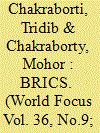

|
|
|
|
|
| Summary/Abstract |
The genesis of BRIC (Brazil-Russia-India-China, predecessor of present-day BRICS) as a multilateral grouping of the four developing or emerging economies can be traced back to September 2006, with the 61st Session of the United Nations General Assembly in New York, in a bid to explore measures of economic and political cooperation among the member-States. Officially, the organization came into existence in 2009, and with the inclusion of South Africa as the fifth member in April 2011, BRIC was re-christened BRICS. Till date, the BRICS member-states have held seven Summits and the latest in Ufa, Russia (July 2015) has been a watershed with the entry into force of the New Development Bank/BRICS Bank and the Contingent Reserves Arrangement. The BRICS Bank is heralded as an alternative to the World Bank-International Monetary Fund-led international economic architecture. However, it remains to be testified whether the BRICS Bank can evolve as a pulsating alternative to the WB-IMF-led financial system, though there is no way denying its establishment as a stepping stone for providing a predominantly South-South economic cooperative mechanism.
|
|
|
|
|
|
|
|
|
|
|
|
|
|
|
|
| 4 |
ID:
140621
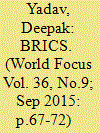

|
|
|
|
|
| Summary/Abstract |
There is no question that this institution will pose as a rival to the Bretton Woods Institutions. The bigger danger for the dollar is the reality that other emerging states that want to break from the conditional ties of the IMF can benefit from the NDB and CRA. The BRICS states make up more than a quarter of the Global GDP and holds less than 11 per cent of the voting rights in the IMF. The United States holds over 16.8 per cent of the voting power in the IMF and along with the countries of Britain, France, Germany and Italy control over 34 per cent of the vote of the IMF. After the crash of Wall Street in 2008 there were efforts by the BRICS group to restructure the World Bank and the IMF to increase the influence of China and other BRICS societies. Wall Street could not countenance this restructuring because the dominance of the Bretton Woods Institutions ensured the military management of the international system in so far as the poorer countries of the world had to keep their reserves in dollars and the US could finance its expenditures from the hard earned savings of other peoples. The BRICS formation will now give the poorer societies a greater say in the international financial order.
|
|
|
|
|
|
|
|
|
|
|
|
|
|
|
|
| 5 |
ID:
140627
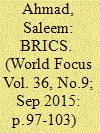

|
|
|
|
|
| Summary/Abstract |
The leaders of the BRICS countries have demonstrated that the establishment of the BRISC bank is a direct blow to the International financial system and it has also remarkably shown the building of the new global economic order that will bring middle economic powers to the global economic affairs. Things have changed rapidly, and the BRICS bank is going to play a pivotal role in financial policies of the developing countries. Moreover, the BRICS countries have indicated to the western countries and especially to the United States of America that nothing is permanent and gone are the days of American dollar; now they have their own currency for trade and exchange among the member countries. This step clearly shows a dent on American dollar hegemony in the world and China’s Yuan is going to rise gradually at the global level. Nevertheless, the fear of China’s dominance among its members can alter the new global economic order and BRICS countries should not give the opportunity to the western countries to play a “divide and rule policy” against its members. They must have faith in each other and can resolve their problems at the bilateral level as well as multi-lateral level.
|
|
|
|
|
|
|
|
|
|
|
|
|
|
|
|
| 6 |
ID:
140617
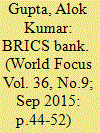

|
|
|
|
|
| Summary/Abstract |
International economic order has always remained biased and discriminatory on account of ‘balance of trade’ being always in favour of developed world. The difference between the developed and the underdeveloped countries grew sharper with the rolling of years in the post-second world war era. While the developed countries made further progress, the condition of under-developed countries did not show any improvement. Consequently, the hiatus between the developed and the under-developed countries went on increasing. The developing countries attributed this to the prevalent international economic order established with the instrumentalities of General Agreement on Tariffs and Trade (GFTT), the International Monetary Fund (IMF), and the International Bank for Reconstruction and Development (World Bank or IBRD).
|
|
|
|
|
|
|
|
|
|
|
|
|
|
|
|
| 7 |
ID:
140626
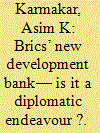

|
|
|
|
|
| Summary/Abstract |
BRICS’ New Development Bank (NDB) comes into prominence as a new international economic order to follow a gradual, but steady process. BRICS summit inFortaleza, Brazil on July 15 is a new signal heralding to open a new chapter that wants to open BRICS' New Development Bank (hereinafter referred to as the NDB ) which has profound implications for global order and development. In fact, the creation of the BRICS bank is significant for future international order for three reasons.
|
|
|
|
|
|
|
|
|
|
|
|
|
|
|
|
| 8 |
ID:
140632
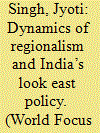

|
|
|
|
|
| Summary/Abstract |
The Look East policy enunciated in early 1990s aimed at engaging with the economically dynamic nations of South East Asia. Indian policy towards Southeast Asia evolved from the imperative of developing stable political and economic relations in the post cold war era and the need to build stronger ties with a region that was growing rapidly. In the initial stage, it was mainly driven by forces of energy and economic requirements. Latter on political, strategic and regional dynamics were also attached. In this paper the regional dynamic of India-ASEAN relations has been discussed. India thinks that ASEAN plays a major role in the Asia-Pacific regionalism. ASEAN serves not only as a regional platform to address Southeast Asia’s regional and global affairs, but also facilitates interaction with other multilateral bodies like the Asia-Pacific Economic Cooperation (APEC), ARF ASEM, SCO etc.
|
|
|
|
|
|
|
|
|
|
|
|
|
|
|
|
| 9 |
ID:
140624


|
|
|
|
|
| Summary/Abstract |
Keeping in tune with the backdrop, in 1967, when ASEAN was founded by Thailand, the Philippines, Malaysia, Singapore and Indonesia, India reacted, as Prof. D.R. Sardesai notes, with ‘coolness, indifference, misgivings and at times, hostility.’ It was seen as an instrument of neo-colonialism and a reincarnation of SEATO. India continued to ignore the fact that the ASEAN states were, in their own distinctive way, preserving their independence and keeping their distance from the major powers. The 1971 Kuala Lumpur Declaration of ASEAN, in fact, sought to preserve Southeast Asia as a ‘Zone of Peace, Freedom and Neutrality.’
|
|
|
|
|
|
|
|
|
|
|
|
|
|
|
|
| 10 |
ID:
140618
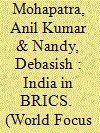

|
|
|
|
|
| Summary/Abstract |
The BRICS, both individually and collectively, have a noteworthy demographic advantage. BRICS constitutes 20% of total world population with a vast cross-continental economic, political and cultural background which may be a technical problem for a multi lateral forum. The impressive economic growth of BRICS countries can influence the global political economy. The five BRICS countries have started to increase their political and economic ties. It should be remembered that each of the BRICS countries has their economic patterns, and rise of the BRICS as a bloc is likely to pose a threat to these interdependencies.
|
|
|
|
|
|
|
|
|
|
|
|
|
|
|
|
| 11 |
ID:
140616


|
|
|
|
|
| Summary/Abstract |
A regional organisation like the Association of South East Asian Nations (ASEAN) is created with an aim to strengthen intra-regional relations and improve cooperation among the nations on various issues where interests appear to be converging with a possible aim, eventually, of regional integration on the model of European Union (EU). A cursory survey of various regional groupings would indicate that their formation, primarily, was guided by geographical considerations, but other categories were later also employed to justify expansion of the organisation beyond the originally declared geographical limits to include extra-regional members, especially if the prospective member happens to be a powerful country like the US or a rising power like India or China. The outcomes of the functioning of all such organisations, however, depend on how powerful member nation or nations steer the happenings of the organisation. This is not to say that comparatively weaker states do not get the benefit from the collective efforts of the member states, the power relations, however, matter in the ultimate analysis.
|
|
|
|
|
|
|
|
|
|
|
|
|
|
|
|
| 12 |
ID:
140629
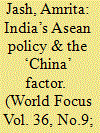

|
|
|
|
|
| Summary/Abstract |
India’s relations with Southeast Asia is one of the promising relations in Asia and that of the 21st century. The relationship is endowed with strong civilizational and cultural links of the past to that of its strategic links in the present-being global economic players, Asian regional giants and most importantly, partners with varied commonality of interests ranging from trade to that of security- both traditional and non-traditional concerns. The end of the Cold War brought about structural changes in the international system that led India to adopt new orientations in its foreign policy. Under this shift, India adopted ‘Look East’ policy in 1992 which resulted into a strategic shift in India’s perspective- bringing Southeast Asia closer to its foreign policy orbit. But with the changes in the global politics as a result of ‘China’s rise’, this relationship too is having a causal effect on its geo-political and security landscape. This ‘China factor’ has thereby elevated the paradigm of India-ASEAN relations to that of a ‘Strategic Partnership’ from being ‘Dialogue Partners’.
It is in this context that the paper examines India’s relations with ASEAN under the strategic interests and concerns. It explores the pertinent aspects that influence the India-ASEAN relations and thereby, argues that India’s policy towards ASEAN has witnessed a shift from just ‘looking towards east’ to that of ‘engaging with the east’.
|
|
|
|
|
|
|
|
|
|
|
|
|
|
|
|
| 13 |
ID:
140622
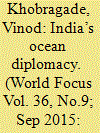

|
|
|
|
|
| Summary/Abstract |
The Chinese maritime strategy in the Indian Ocean is wider especially for economic development and the regional integration and subsequently, to establish military base in the IOR. However, India’s plan in the IOR is to counter China’s growing maritime power in the region. Therefore, in this direction, India has a pragmatic strategy for the regional engagement with all. But balancing China’s economic and military intrusion in the region is formidable and more complex challenge. The fact of the important matter is that India should have more purposeful and clear engagement in Indian Ocean without feeling China as a challenge. India needs to materialize its capabilities and skillful maneuverability in bringing the island nations of the Indian Ocean into its periphery of influence boosting and building confidence building for the greater consolidation of bilateralism and multilateralism wherever possible in the direction of security and economy. However, to accomplish the set objectives in the Indian Ocean, the region must be a zone of peace for the protection of national interests of all the states. In fact, it will not be an exaggeration to argue that the rise in China’s maritime profile in the Indian Ocean has compelled India to focus on its proactive maritime strategy.
|
|
|
|
|
|
|
|
|
|
|
|
|
|
|
|
| 14 |
ID:
140630
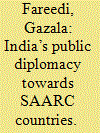

|
|
|
|
|
| Summary/Abstract |
The purpose of this paper is to assess the nature of India's public diplomacy towards South Asia and critically evaluate its performance. It argues that India’s public diplomacy (PD) efforts are more focused on other regions rather than the South Asian Region. This apparent lack of focus is due to the fact that India’s foreign policy has not been pro-active towards its immediate neighbours except for policies such as the Gujral Doctrine, which have since become stagnant. The lack of focus on SAARC countries by India’s PD division is also because most of India’s New Public Diplomacy (NPD) is focused on the domestic public rather than the foreign public. This is quite contrasting to the general trend elsewhere wherein States have oriented their PD efforts to reach foreign audiences to improve their soft power. Thus, the paper suggests a review of India's public diplomacy efforts to expand its reach and influence in this area.
|
|
|
|
|
|
|
|
|
|
|
|
|
|
|
|
| 15 |
ID:
140610
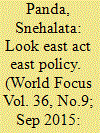

|
|
|
|
|
| Summary/Abstract |
CMLV are promising economies for intensive engagement. But challenges are many .The present approach is in sync with their aspirations as well as India’s endeavour to knock the Asian Century into shape.A new dynamism characterizes India’s foreign policy through increased frequency of interactions with small ,medium and great powers of the world including those which were not in the diplomatic basket and those which had slipped out of it .Reinvigorated relationships reflect the personality of our leaders managing foreign affairs, their ability to replace diplomatic jargon with an informal style for interaction and allowing enough space for operationalisation of soft power buttressed by a clear electoral mandate .The geo-economic realities coupled with historical and cultural affinity as well as gestures to respect sovereign equality of nations despite their size and resources have enlivened an environment of trust in most of the neighbouring countries .This is reinforced by India’s response to disaster management , prompt action to fulfill promises and resolution of some unsettled bilateral problems. External relationship has immense repercussion on domestic issues particularly economic growth and the recent initiatives evince genuine effort to achieve this objective.
|
|
|
|
|
|
|
|
|
|
|
|
|
|
|
|
| 16 |
ID:
140608


|
|
|
|
|
| Summary/Abstract |
The SAARC was designed to improve both the economic and social progress of its member states. But, unfortunately ever since its formation there have been hindrances to the regional cooperation. Differences in political system among the member countries make regional cooperation difficult. Asean countries must decide whether to retreat into protectionism or reaffirm their commitment to a more open approach. It does not have the kind of deep institutional ties and infrastructure links that bind together the European Union’s members. If integration strategy is fully implemented and capturing a larger share of global manufacturing, the Asean countries could gain $280-625 billion in annual gross domestic product (GDP) by 2030.
|
|
|
|
|
|
|
|
|
|
|
|
|
|
|
|
| 17 |
ID:
140633


|
|
|
|
|
| Summary/Abstract |
Over the past few years, the global economy’s centre of gravity has been moving away from the advanced countries, as the emerging economies have become the new growth poles. The focus on the emerging economies has increased considerably since the BRIC countries not only convened the first meeting of their leaders in 2009, but also added South Africa in less than three years. The paper examined the nature of co-ordination among the BRICS countries, and whether the presence of South Africa has made a difference to the group’s dynamics. There are areas in which the emerging economies have co-ordinated their positions and have thereby been able to put up a joint front. This has been most visible in the WTO negotiations on intellectual property rights and agriculture, the two areas in which the developed countries have dominant positions. But while in the WTO, the emerging
economies were proactive in making joint interventions in the climate change negotiations to further their aspirations. It is the ability of the BRICS to set the global economic agenda in forums like the G-20 that would mark the coming of age for the grouping. Thus far, they have not made any substantive alterations in the dynamics at the ‘high table’. A more co-ordinated approach on issues that unify them would better enable and strengthen them, and would help to justify their presence on the ‘high table’.
|
|
|
|
|
|
|
|
|
|
|
|
|
|
|
|
| 18 |
ID:
140619
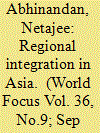

|
|
|
|
|
| Summary/Abstract |
The Asian countries have failed to get their acts together. Despite the economic imperatives pushing for a grand alliance among the Asian countries along the lines of European Union, any such formation had not been possible even after more than a decade into the 21st century. In fact, Asia, of late, has become a hotbed of conflicts, controversies and contradictory claims and counter-claims among the various countries. The increasing tensions over territorial disputes, rising military budgets and dawdling economic growth threaten to “impede trade, tourism and investment especially if incidents occur between rival air or naval forces operating in close proximity over or around disputed waters and territories. Cyberspace is another domain in which competition could get out of hand.” As Asia is passing through a phase of transition- from poverty and political irrelevance to prosperity and political dominance- it has to contend with power imbalances and growing security challenges. The resurfacing of Cold War era territorial and maritime disputes has led to formation of alliances and counter-alliances and reconfiguration of power equations in the region. The intensification of geo-political competition among the major Asian countries has thwarted any attempt towards political integration that would have resulted from greater economic interdependence.
|
|
|
|
|
|
|
|
|
|
|
|
|
|
|
|
| 19 |
ID:
140634


|
|
|
|
|
| Summary/Abstract |
India’s relationship with Singapore has been one of the closest relations it has developed with countries of the ASEAN region. This in part was driven by a multitude of factors including the Indian and Singaporean side wishing to have bilateral gains as well as add to the stability of the region by investing in enhancing the balance of power in the region. The ‘more the merrier’ philosophy of ASEAN countries has been the result of the states of the region to resorting to the inclusion of India in the mix. The initial thrust provided by Singapore has proved in strengthening India’s position and diplomacy in the region. This has been seen in a number of instances where states in the region have pushed for India to play a stronger role.
However, India’s own growing economic profile and military capability have also worked to ensure its potential courting by states in the region. The Indian economy’s resilience displayed in the late 90’s up until the mid 2000’s has been helpful in cementing India’s ability to rise to become one of the larger economies in Asia. The challenge however has been to work through the strong and capable networks which China has developed in the region. The interdependence which has developed is now working to have an impact on ASEAN as China is strengthening as a military and economic power. This has been evident in the case of China and the South China Sea dispute. Therefore, without the increasing participation of other major extra regional powers, the possibility of avoiding a non beneficial interaction with China is very much a reality for ASEAN states. India’s presence will also help in maintaining the security and safety along the Sea Lines of Communication in the region which is not only important for the region but also for world trade and success of ASEAN’s initiative to build an economic consensus in the region. A step towards building interoperability will be useful in countering security threats.
|
|
|
|
|
|
|
|
|
|
|
|
|
|
|
|
|
|
|
|
|